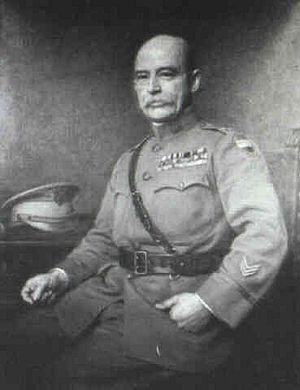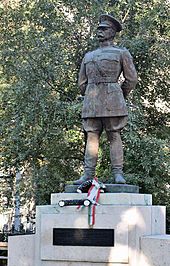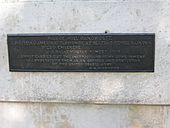Harry Hill Bandholtz facts for kids
Quick facts for kids
Harry Hill Bandholtz
|
|
|---|---|

Harry Hill Bandholtz (painting) by Gyula Stetka (1920)
|
|
| Born | December 18, 1864 Constantine, Michigan, U.S. |
| Died | May 7, 1925 (aged 60) Constantine, Michigan, U.S. |
| Buried |
Constantine Township Cemetery, Constantine, Michigan
|
| Allegiance | |
| Service/ |
|
| Years of service | 1890–1923 |
| Rank | |
| Unit | 29th Division |
| Commands held | Military District of Washington 58th Brigade, 29th Division |
| Wars | Philippine–American War Spanish–American War World War I |
| Awards | Distinguished Service Medal Silver Star |
| Spouse(s) | 1. May Cleveland (divorced in 1922) 2. Inez Claire Gorman |
| Relations | Cleveland Bandholtz (son) |
Harry Hill Bandholtz (born December 18, 1864 – died May 11, 1925) was an important officer in the United States Army. He spent over ten years serving in the Philippines. During World War I, he became a major general. He also represented the US in a special military group in Hungary in 1919.
Contents
Growing Up and Starting Out
Harry Hill Bandholtz was born in Constantine, Michigan, on December 18, 1864. He was the younger of two children. His father, Christian Johan Bandholtz, came from Schleswig-Holstein and worked as a harness maker. His mother, Elizabeth Hill, made and sold hats. Harry went to local schools and finished high school in 1881.
After school, he first worked as a billing clerk in his hometown. Later, he moved to Chicago and became a bookkeeper for a trading company. While in Chicago, Harry joined the National Guard. He also met May Cleveland there, and they got married in 1890. They had one son named Cleveland Hill Bandholtz.
Harry's Military Journey
Harry was drawn to a career in the military. He earned a spot at the United States Military Academy (West Point). He graduated in 1890. From 1890 to 1898, he was an active officer in the US Army. He also taught at the Michigan Agricultural College.
After this, he joined the Spanish–American War and was sent to Cuba.
Serving in the Philippines
In July 1900, Bandholtz was sent to the Philippines during the Philippine–American War. He served there for 13 years. At that time, the US had taken control of the country. Many Filipinos saw Americans as just another group trying to rule them, after being under Spanish rule for a long time.
However, Bandholtz was seen as honest and fair. He seemed to earn the trust of the Filipino people. In 1902, he became the Provincial Governor in Tayabas Province in the Philippines. He was the only American Army officer ever elected by the Filipino people. As an Army captain, he also supported Manuel L. Quezon, who later became a president of the Philippines.
In 1903, Bandholtz was made a Colonel in the Philippines Constabulary. This was a police force. By June 1907, he was promoted to Brigadier General. In 1907, he was also chosen to lead the Veteran Army of the Philippines. He served as the Chief of the Philippines Constabulary until 1913. During this time, US and Philippine forces continued to fight against groups resisting American rule in some areas. This fighting ended in 1913.
The next year, Bandholtz helped combine the United States Spanish War Veterans with the Veteran Army of the Philippines. This group eventually became the Veterans of Foreign Wars, a large organization for military veterans.
Bandholtz supported the US government's rule in the Philippines. He was known for convincing rebel leaders to give up. Once, he walked unarmed into a rebel camp with a local guide. After talking with Colonel Antonio Loamo, Loamo surrendered with 70 men and 30 rifles.
After the Philippines
After his time in the Philippines ended in 1913, Bandholtz returned to the US. He became a Major in the US infantry. He was put in charge of the 29th Infantry and became Commander of Fort Porter, New York. He also served as Chief of Staff for the New York National Guard and traveled to the border of Mexico.
In 1917, he was promoted to lead the 58th Brigade of the 29th Division. He went with his unit to France in June of that year, serving for three months after the US joined World War I. On September 27, he was named the United States Army Provost Marshal General. This meant he was the chief military police officer for General John J. Pershing's forces in France. He held this important job until 1919.
General Bandholtz reorganized the Military Police Corps. He also started a Military Police school in Autun, France. He believed that the Military Police Corps should be a permanent part of the army after the war. Because of his work, Bandholtz is often called the "father" of the United States Army's Military Police Corps.
Mission in Hungary
From August 1919 to February 1920, Bandholtz was the US representative for a special military group in Hungary. This group was tasked with making sure the Hungarian military was disarmed. They also watched over the withdrawal of Serbian and Romanian armies that were occupying parts of Hungary. The Allies had promised that people could decide their own futures after empires like Austria-Hungary broke apart.
Bandholtz is famous for stopping the Romanian military from taking valuable items from the Hungarian National Museum on October 5, 1919. He was "armed" only with a riding crop. He locked the doors and put up signs that said, "This door sealed by Order the Inter-Allied Military Commission. H.H. Bandholtz, President of the Day, October 5th, 1919." The Romanians wanted to take back items they believed were stolen from their libraries and museums during the war.
Bandholtz also helped prevent the arrest of Hungarian Prime Minister István Friedrich by the Romanians. He even stopped 135 Romanian trucks from taking materials from a factory.
Later Service and Retirement
After returning to the US, Bandholtz commanded the 13th Infantry Brigade in Kansas. This camp was used to train soldiers for World War I.
In 1920, there was a conflict among miners in Mingo County, West Virginia. President Warren G. Harding sent General Bandholtz and General Billy Mitchell to help control the situation. Federal troops were eventually sent in, and the fighting stopped.
The 13th Brigade was closed in August 1921. Bandholtz then became the commanding general of the Military District of Washington. On January 28, 1922, Bandholtz helped with rescue efforts when the Knickerbocker Theatre collapsed during a big snowstorm. Many people were killed or injured. Bandholtz received a special letter of praise for his quick actions.
Bandholtz retired from active service on November 4, 1923, due to health issues. He was promoted to the rank of major general. He received many awards during his military career. These included the Distinguished Service Medal and the Silver Star from the US. He also received honors from other countries, like the French Legion of Honor and the Romanian Grand Cross. The Romanian Grand Cross was a very rare award for an American.
Personal Life
Bandholtz and his first wife, May, separated in 1918 after 28 years of marriage. They divorced in 1922.
In April 1922, Bandholtz married Inez Claire Gorman in New York City. She was 25 years younger than him. This marriage caused some tension with his only son, Cleveland, who was also an army officer.
Bandholtz had heart problems later in his life. He died on May 7, 1925, at the age of 61. He is buried in the Constantine Cemetery in Constantine, Michigan.
Memorial in Budapest
In 1936, the Hungarian government honored Bandholtz with a statue in Szabadság tér (Liberty Square) in Budapest. It stands across from the US embassy. The statue has a quote from him:
I simply carried out the instructions of my government, as I understood them, as an officer and a gentleman of the United States Army.
The statue, made by Hungarian sculptor Miklós Ligeti, shows Bandholtz holding his riding crop. This refers to the story where he stopped the Romanian military from looting the National Museum with just his crop and his strong personality. This event is described in his book, An Undiplomatic Diary by the American Member of the Inter-Allied Military Mission to Hungary, 1919–1920. Today, his actual riding crop is on display in the Hungarian National Museum.
After World War II, the statue was fixed. But in 1949, the new Communist government removed it. In 1985, it was moved to the garden of the US Ambassador's home. It was finally returned to its original spot in front of the US embassy on July 6, 1989. This was just before President George H. W. Bush visited Budapest. The quote on the statue was put back in 1993, after the Soviet Union broke apart.
Legacy
Harry Hill Bandholtz's personal papers and writings are kept at the University of Michigan's Bentley Historical Library.



